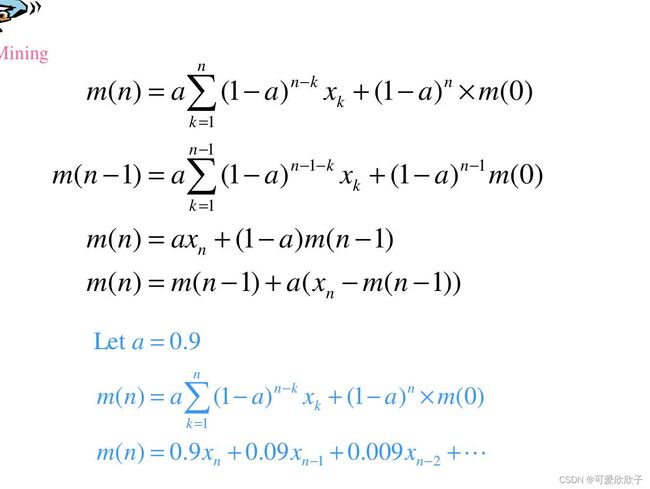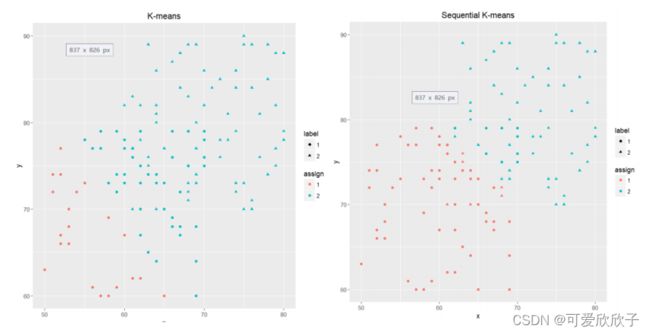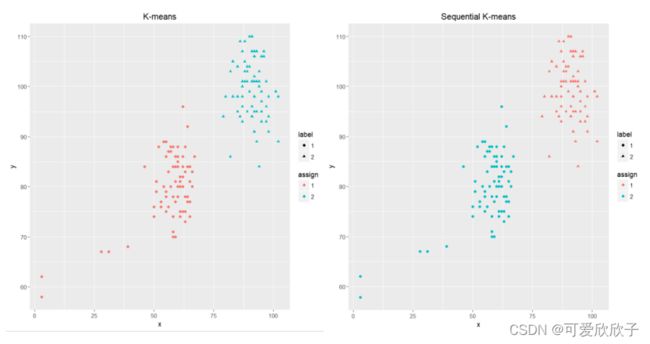R语言聚类——KMeans家族(Simple K-Means、Sequential K-Means、Forgetful Sequential K-Means)
文章目录
-
- Simple K-Means
-
- R语言代码实现
- Sequential K-Means
-
- R语言代码实现
- Forgetful Sequential K-Means
- K-Means家族算法在各类型数据集上的表现
- K-Means聚类需要关注的问题
-
-
- 1. 空聚类
- 3. 初始质心的选择
- 5. 离群点(Outliers)
- 7. k值的选择
-
K-Means家族有三个算法:
- Simple K-Means
- Sequential K-Means
- Forgetful Sequential K-Means
接下来我会简单介绍一下这几个算法,并分析它们的特点和优劣。
Simple K-Means
最简单的聚类算法就是K均值(Simple K-Means)算法。其核心思想如下:
假设有k个聚类(clusters),每个聚类有一个质心(centroid),其中质心是每个聚类中实例的均值(means),数据集中的每个点被指派给与该点距离(distance)最近的质心所在的聚类。
- 首先估计每个聚类的中心(means):m1,m2 …mk
- 在所有中心(m1-mk)都不变前循环以下步骤:
1)将每个实例分配到最距离最近的中心的聚类中;
2)计算每个聚类新的均值,并更新m1-mk的值。
以下为迭代次数为6的kMeans聚类的例子,每个“+”为当前迭代的聚类质心,第一次迭代的质心为随机估计值。

R语言代码实现
其中,参数clusterNum为最后需要聚类的个数,maxLiteration为最大迭代次数,clusters为预先生成的数据集(生成方式见上一篇笔记)
# K-Means
kMeans <- function(clusterNum, maxLiteration,clusters) {
# The condition of whether the loop ends
END = FALSE
# Count the literation times
literation = 0
# 'centers' is a matrix with randomly choosed centroids
centers <- clusters[sample(nrow(clusters), clusterNum, replace = F), c("x", "y")]
centers <- cbind(centers, cname = c(1:clusterNum))
# The function find the closest centroid to the vector and assign the vector to the cluster
# This function is used by apply()
kMeansAssignCluster <- function(x, centers) {
minDist <- 10e10
centerIndex <- 0
for (center in 1:nrow(centers)) {
dist <- dist(rbind(x, centers[center,]))
if (dist < minDist) {
minDist <- dist
centerIndex <- center
}
}
centers[centerIndex, "cname"]
}
# Keep looping when not receiving END sign and literation times lower than 100
while (!END & literation < maxLiteration) {
# Assign each vector to the closest cluster
av <- apply(clusters[, c("x", "y")], 1, kMeansAssignCluster, centers = centers)
# Store the assigned result into data set
clusters <- data.frame(clusters[, c("x", "y", "label")], assign = as.character(av))
END <- TRUE
# Recalculate the centroids, if different from the previous one, update them and keep looping
for (assignCluster in 1:clusterNum) {
newCenter <- round(apply(clusters[clusters$assign == as.character(assignCluster), c("x", "y")], 2, mean))
dif <- centers[assignCluster, c("x", "y")] - newCenter
if (mean(as.matrix(dif)) != 0) {
END <- FALSE
centers[assignCluster, c("x", "y")] <- newCenter
}
}
literation <- literation + 1
}
print(literation)
# Draw the diagram
print(ggplot(data = clusters, mapping = aes(x = x, y = y, shape = label, color = assign)) + geom_point()+ labs(title = "K-means"))
}
Sequential K-Means
它与Simple K-Means的区别在于,它使用了增量更新的策略。即其优势在于:
- 每次获取一个新的实例(example)都更新一次均值,而k-means是将所有实例分配完后更新均值。
- 可以实现在获取所有实例之前就开始聚类。
其核心思想如下:
- 首先估计每个聚类的中心(means):m1,m2 …mk;
- 设置计数器(count):n1,n2 … nk 的值为0;
- 在所有中心(m1-mk)都不变前循环以下步骤:
1)获取一个新的实例(example)x;
2)若mi的距离与x最近:将计数器ni加1且将mi替换为mi+1/n(x-mi)。
R语言代码实现
# Sequential K-Means
SequentialKMeans <- function(clusterNum,maxLiteration) {
# The condition of whether the loop ends
END = FALSE
# Count the literation times
literation = 0
n <- numeric(clusterNum)
# 'centers' is a matrix with randomly choosed centroids
centers <- clusters[sample(nrow(clusters), clusterNum, replace = F), c("x", "y")]
centers <- cbind(centers, cname = c(1:clusterNum))
# Keep looping when not receiving END sign
while (!END) {
for (vector in 1:nrow(clusters)) {
x <- clusters[vector, c("x", "y")]
minDist <- 10e10
centerIndex <- 0
for (center in 1:nrow(centers)) {
dist <- dist(rbind(x, centers[center, c("x", "y")]))
if (dist < minDist) {
minDist <- dist
centerIndex <- center
}
}
n[centerIndex] <- n[centerIndex] + 1
# Update Center
centers[centerIndex, c("x", "y")] <- centers[centerIndex, c("x", "y")] + (1 / n[centerIndex]) * (x - centers[centerIndex, c("x", "y")])
clusters[vector, "assign"] <- as.character(centers[centerIndex, "cname"])
}
literation <- literation + 1
if (literation >= maxLiteration) {
END <- TRUE
}
}
print(ggplot(data = clusters, mapping = aes(x = x, y = y, shape = label, color = assign)) + geom_point() + labs(title = "Sequential K-means"))
}
Forgetful Sequential K-Means
它与Sequential K-Means的区别在于,它不再进行计数,而是将n/1替换为一个常数a(即替换mi = mi+a(x-mi))。则有:

由上图可见,“Forgetful”体现在,越往后面的实例权重越高,因此最初的m0会被渐渐“遗忘”。
因此,Forgetful Sequential K-means比较适合问题随时间不断改变的情况。
因为Forgetful Sequential K-means的代码与Sequential K-means的几乎一样,只需要取消计数并把质心的更新参数换成常数a,所以这里不再放出。
K-Means家族算法在各类型数据集上的表现
数据集为用上一篇文章生成的数据集,分别使用上面的代码对它们进行聚类,以下是Simple K-means和Sequential K-means的表现:
- 重叠(Overlapping)

- 噪声(Noise)

- 环形

由结果可见,K-Means家族的算法不太适合重叠(Overlapping)的聚类,但在有噪声的聚类下表现还不错。另外K-Means不太适合不同形状的聚类,因为所有聚类最后都是一团一团的。
K-Means聚类需要关注的问题
1. 空聚类
由于更新质心时需要计算每个实例的平均值,即m=1/n(x1+…+xn),而n取决于有多少实例被分配到该聚类。因此有可能出现某个聚类一个实例都没有的情况,这在计算中会出现问题,即n=0且n为分母。
解决方式为:可以将n=0的质心替换为一个比较大的聚类中的一个点。(这在我的代码中没有体现,但加上去也不难,暂时没加)
3. 初始质心的选择
实验表明,初始质心的选择会极大影响到聚类效果,但初始质心需怎么估计呢?
- 一个方式为选择比需要的聚类个数更大的k,聚类完成后再通过后处理(post-processing)合并一些类;
- 勤奋!多跑几次找到效果最好的~
5. 离群点(Outliers)
离群点也会影响k-means的效果,因为它们会在迭代过程中把质心拉偏。
所以数据预处理很重要!把离群点弄走,或者标准化数据~
7. k值的选择
如何确定合适的k值?
数据后处理(post-processing)
把小的聚类丢掉
分开数据分布很松散的聚类,合并数据分布紧密的聚类。